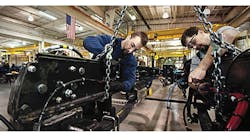The manufacturing skills gap continues to hinder large portions of the industry and represents a significant impediment and threat to manufacturing growth and the adoption of new technologies, according to a new report, Industry Pulse: 2018 Manufacturing Workforce Report, released earlier this month.
According to the report, the top business challenges for manufacturers are finding, upskilling, and onboarding talent -- even for most otherwise successful companies.
"Manufacturing is in the midst of a new industrial revolution that requires a workforce equipped with new, advanced technology skills,” said Jeannine Kunz, vice president, Tooling U-SME. “Putting learning and development on the back burner is not an option for companies that want to succeed in today's ever-changing and increasingly competitive world.
"Leaders, including senior executives and management, must make their workforce a strategic priority if they want their companies to maximize growth," added Kunz.
Key findings of the report include:
--The overwhelming majority of manufacturers say they will face significant challenges developing a skilled workforce in the next three years: finding experienced new hires (99%; upskilling the incumbent workforce (92%); and onboarding new employees (84%).
--Despite the clear need for stronger training and development, only two out of five manufacturers (41%) agree their company trains people to develop skills.
--Retaining trained employees is also a challenge; two out of five manufacturers (43%) average 20% or higher annual turnover.
--Respondents blame lack of management commitment and resources – i.e., funding, time, and training – for not investing in workforce learning and development.
The groups recommend that companies execute strategies now to ward off the skills gap – e.g., developing a strong onboarding process, instituting a formal training program, encouraging continual education, and properly upskilling those responsible for training workers will help companies maintain a highly-skilled workforce.
"It's imperative that manufacturers start now to train their employees – and their trainers – effectively, so these workers fully understand how to use equipment and technology to their fullest, as well as improve processes and generate new ideas," adds Kunz. "With proper training, manufacturers can greatly impact their hiring, onboarding and retention."



